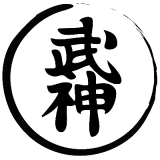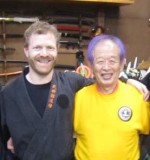Glossary
Just starting out, there are a lot of new names and terms to work out. Here are some of the common ones.
Kyu and Dan grades
Common to many Japanese martial arts, a new student starts as a ‘white belt’, someone with no rank or grade. As they progress, they move through the ‘kyu grades’, starting at 9th Kyu then counting down to 1st Kyu. In the Bujinkan, you’ll keep the same belt colour (usually green) through all the kyu grades, rather than changing at every new rank. The next level after 1st Kyu is 1st Dan, or shodan. This is the first ‘black belt’ grade. You can then become a 2nd Dan, 3rd Dan, and so on.
Shidoshi
A Shidoshi is a licensed instructor. Someone must achieve the rank of 5th Dan before being allowed to become a Bujinkan instructor, and therefore open a dojo. People below 5th Dan can be Shidoshi-ho, meaning ‘Assistant Instructor’, if they are sponsored by a full Shidoshi.
Shihan
Shihan are those senior practitioners who are the most senior instructors, meant as the role models for everyone else. These people are not usually less than 10th Dan.
Gi and Tabi
The Gi is the standard martial arts wear. Made of tough cotton or canvas and heavily reinforced, it’s meant to withstand all sorts of tough training. It consists of a pair of cord-tie trousers, and a long sleeved jacket, which needs to be tied shut by a belt. It’s designed this way so that there are no buttons or zips to land on, reducing the chance of injury.
Tabi are Japanese split-toed socks. Jikatabi, which most ninjutsu practitioners wear, are hardier versions, used by carpenters, people in street festivals, and so on, as well as martial artists.

Wooden weapons
There are many traditional weapons used in Ninjutsu, many of which are wooden, and some are metal. Generally, we use wooden versions of everything, in the interests of safety and economy.
Katana Mid-sized and most common type of Japanese sword.
Bokken and Subarito Wooden training sword, the Subarito is a heavier version.
Wakizashi Short sword
Shoto Literally ‘Short sword’, it’s also used to refer to the short wooden training sword.
Tanto A short knife, either metal or wooden.
Bo 6ft staff
Jo 4ft staff or ‘chin height’, depending on school
Hanbo 3ft staff, or walking stick height
Naginata Equivalent of a western halberd, and has a variety of blade shapes and sizes.
Yari A spear, carried by the mainstay of Japanese armies, the Ashigaru (‘light foot’).
Kyoketsu Shoge A combined spear tip and sickle, attached to a long chain with an iron ring at the other end.
Kunai A digging tool, a bit like a trowel.
Tessen An iron fan, either one that can open and be used, or just a solid bar made to look like a real fan.
Kusari fundo A short length of chain with small iron weights at either end.
Kusari gama A sickle, with a short length of chain attached, and an iron weight at the other end.
Shuriken Throwing weapons, in either star or spike shapes.
Jutte A sword-breaking and restraint weapon, that looks like half an Okinawan Sai; a metal rod with a grip at one end, and a spur.
